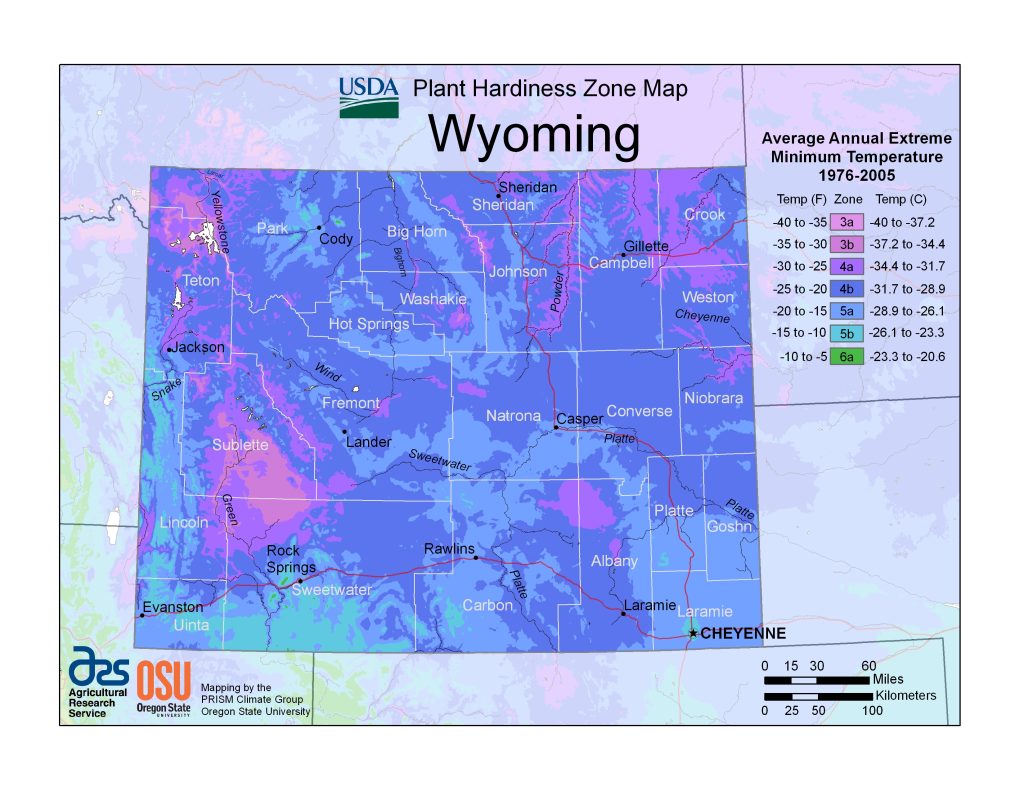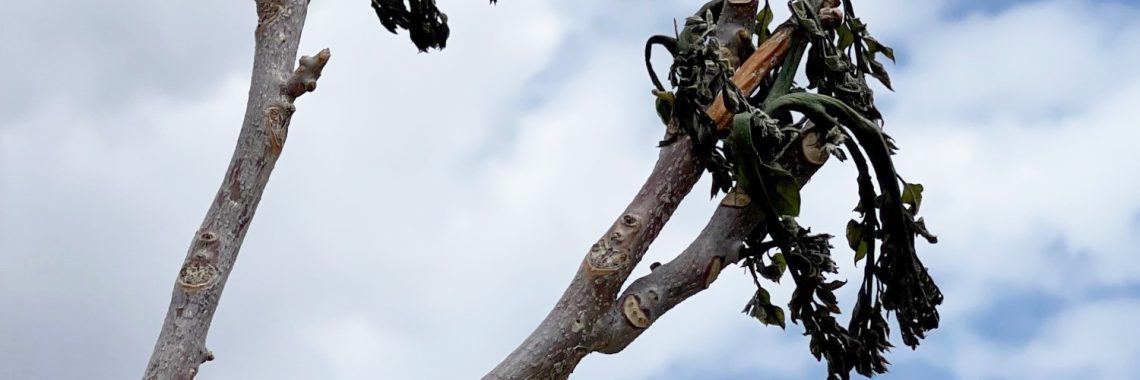Trees, shrubs, and other perennial plants must withstand cold temperatures to survive in Wyoming’s harsh climate. Plant cold hardiness is based on the plant’s ability to withstand the average annual minimum winter temperature in an area. Wyoming hardiness zones run from 3a to 6a, with most areas rated as zones 4 or 5 (-30 to -15 degrees Fahrenheit), as shown in Figure 1.
Unfortunately, even selecting trees rated for the appropriate hardiness zone does not guarantee protection from cold injury. Extreme, untimely freezes have become more common in the last couple decades, creating challenges for those seeking to cultivate healthy trees.

Fall freeze
The process of becoming cold hardy is known as acclimation. Acclimation occurs gradually, beginning in late summer and extending well into winter. Decreasing day length followed by cool, then freezing, temperatures allows trees and shrubs to develop cold hardiness.
For many plants, maximum cold hardiness is normally achieved in mid-winter (January). If extremely cold temperatures occur early in the season, tree damage may result.
Moderate fall freezes with temperatures dipping into the 20s or teens (°F) are often of little concern. It is when temperatures in the single digits or below zero occur in fall or early winter—October, November, December—that tree health can be impacted. Such freezes are most likely to cause damage if temperatures were unseasonably warm prior to the freeze.
Symptoms
Fall freeze damage symptoms often do not develop until warm temperatures arrive. Frozen needles of conifers, for example, remain green while the weather is cold, but turn brown during an extended winter thaw or as spring warming begins (Figure 2). Sometimes the injury may escape notice until spring, when observers realize that normal plant development is not occurring (as when buds killed by an untimely fall freeze fail to open).
Some types of freeze injury take a year or more to show up. In the summer and fall of 2015, the trunks and limbs of ornamental pear trees in Wyoming cracked, and large sheets of bark peeled and sloughed off (Figure 3). Looking back at the weather of the previous year offered a clue: a severe cold wave enveloped much of the nation in mid-November 2014. Temperatures across Wyoming dropped well below zero for multiple nights, and the tissues below the bark that had not fully acclimated were damaged. The following spring, trees leafed out (poorly in many cases), but the bark clung to their trunks and limbs for many months before falling away.
Cankers
Trees suffering from severe fall freeze damage are often more susceptible to pests. One such pest is a “canker,” a disease caused by a fungus that kills trunks, branches, and twigs. Similar to a virus that lies dormant in humans, the canker fungus infects trees and remains quiescent until a stressful condition (such as an untimely severe freeze) allows it to take advantage of the weakened tissues.
Once again, the symptoms are delayed. Typically, affected trees flush with normal spring growth, but the spreading canker infection causes the new growth or branches to die (Figure 4). Cankers attacking the trunk of a small tree can kill the entire tree.
Spring freeze
Damaging spring freezes can occur any time after trees have emerged from dormancy and young leaves and flowers are beginning to develop. Often this happens in late spring, but if a prolonged warm spell occurs in late winter or early spring, trees may be tricked into believing winter is over and begin to de-acclimate and push new growth.
Freezing spring temperatures kill new leaf and flower tissues, causing them to turn limp and brown in a day or two (Figures 5 and 6). Twigs and buds may be killed as well. New growth from adventitious buds may eventually occur, but the dead, bare twigs remain for weeks (Figure 7).
Leaf tatter
A delayed symptom of spring freeze is a condition known as leaf tatter—the presence of numerous ragged holes between leaf veins (Figure 8). Leaf tatter develops after buds break dormancy and the protective papery bud scales surrounding the delicate bud tissue begin to loosen. Tiny areas of developing leaf tissue become exposed to cold temperatures and die. As the leaves unfold and expand over the next few weeks, the tiny dead areas develop into holes. Because symptoms appear weeks after the freeze event, leaf tatter is often mistaken for insect feeding.
Winter sunscald
Sunscald is a type of freeze damage that occurs mid-winter. Characterized by long, vertical bark damage on the south or southwest side of the trunk, sunscald is common in trees with thin, smooth bark, especially young trees.
During very cold winter weather on bright, sunny days, the southwest side of the trunk warms up. When the sun sets, the tissues quickly freeze. Affected bark may turn pink or reddish in color and become rough or cracked; dead areas may peel off. Often the bark splits and exposes the wood (Figure 9).
The loss of overhead branches or nearby trees that previously shaded the bark can lead to sunscald. However, the following improper cultural practices strongly predispose trees to sunscald:
- Lack of supplemental water in newly planted trees;
- Poor pruning jobs that leave a branch stub or cut too close to the trunk;
- Trunk damage from mowers or string trimmers;
- Root damage (for example, from trenching near the tree or from girdling roots).
Protecting trees from these types of damages is the key to preventing winter sunscald.
Managing for freeze damage
You can’t control the weather, but these tips will improve the health of your trees, allowing them to properly prepare for freezing conditions and rebound from freeze damage.
Select trees with a hardiness zone rating suited to your location.
Use organic mulch, such as wood chips or pine needles, to help improve root health and provide some insulation from winter cold. Roots are the most cold-sensitive part of the tree, so when snow cover is absent, roots are at risk for injury.
Water trees during drought. Spring, summer, and fall are the most important seasons, but if soils are dry and unfrozen, watering in winter can provide some benefit.
Avoid fertilizing with nitrogen or pruning trees in late summer. Nitrogen applications and pruning stimulate new growth, which will not have time to properly acclimate before winter.
Freeze-killed and cankered branches should be pruned back to a healthy main branch or the trunk. Extensively damaged trees may not be salvageable.
To avoid sunscald, provide supplemental water to newly planted trees and follow proper pruning methods—neither cutting too close to the trunk, nor leaving a branch stub. A ring of organic mulch helps keep mowers from damaging the trunk.
Protect the trunk by erecting a board to the south and west of the tree to provide shade. Tree wrap is another option, but it must be removed in spring.
Over time and with proper care, trees with sunscald damage may close the wound with new wood. However, the area may be structurally weak and prone to pest attacks. Removal and replacement of young, severely damaged trees may be a better option.
For assistance in identifying and managing freeze damage, contact your local UW Extension office.
Reprinted from Barnyards & Backyards magazine’s Winter 2023 issue. For more information or to subscribe, visit http://www.uwyo.edu/barnbackyard/magazine/.





